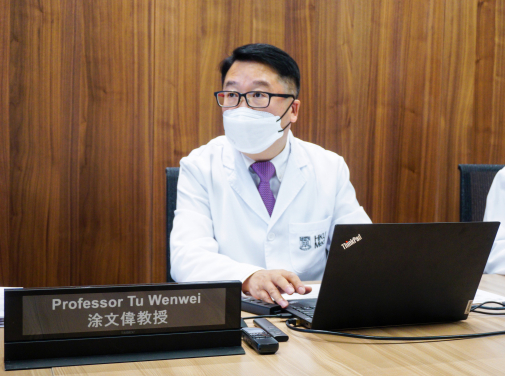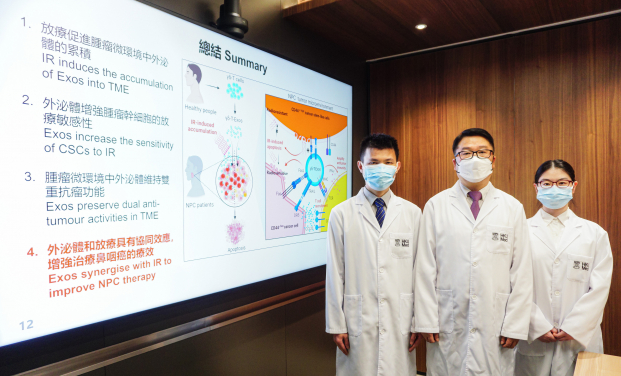Media
HKUMed develops a novel therapeutic approach against nasopharyngeal carcinoma by using exosomes derived from γδ-T cells synergised with radiotherapy
06 May 2022

The research was led by Professor Tu Wenwei, Department of Paediatrics and Adolescent Medicine, School of Clinical Medicine, HKUMed

HKUMed develops a novel therapeutic approach against nasopharyngeal carcinoma by using exosomes derived from γδ-T cells synergise with radiotherapy. The research was led by Professor Tu Wenwei, Department of Paediatrics and Adolescent Medicine, School of Clinical Medicine, HKUMed (middle) and Dr Wang Xiwei, post-doctoral fellow of Professor Tu’s team (left), is the first author. PhD student Zhang Yanmei (right) is a member of the research team.

The research was led by Professor Tu Wenwei, Department of Paediatrics and Adolescent Medicine, School of Clinical Medicine, HKUMed

HKUMed develops a novel therapeutic approach against nasopharyngeal carcinoma by using exosomes derived from γδ-T cells synergise with radiotherapy. The research was led by Professor Tu Wenwei, Department of Paediatrics and Adolescent Medicine, School of Clinical Medicine, HKUMed (middle) and Dr Wang Xiwei, post-doctoral fellow of Professor Tu’s team (left), is the first author. PhD student Zhang Yanmei (right) is a member of the research team.
- 1 / 2
- 2 / 2
A research team at LKS Faculty of Medicine, The University of Hong Kong (HKUMed) discovered that exosomes derived from γδ-T cells (γδ-T-Exos) synergised with radiotherapy can control nasopharyngeal carcinoma (NPC) by overcoming the radioresistance of NPC cancer stem cells (CSCs) and preserve their tumour-killing and T cell-promoting activities in the immunosuppressive NPC microenvironment. This study provides a proof of concept for a novel and potent strategy by combining γδ-T-Exos with radiotherapy in the control of NPC. The ground-breaking findings have been published in the leading academic journal, Journal for Immunotherapy of Cancer [Link to the publication].
Background
Nasopharyngeal carcinoma (NPC) is one of the most aggressive Epstein-Barr virus (EBV)-associated tumours, which are very prevalent in East Asia, including Hong Kong. Radiotherapy is the first-line treatment for NPC, but its therapeutic efficacy is poor in some patients due to radioresistance. Adoptive T cell-based immunotherapy has also shown promise to control NPC; however, its anti-tumour efficacy may be attenuated by an immunosuppressive tumour microenvironment. Exosomes are endosome-originated small extracellular vesicles that mediate intercellular communication. Compared with cell-based therapy, cell-free exosomes have advantages with higher safety, easier storage and lower costs. In a previous study, researchers have demonstrated that γδ-T-Exos could effectively control the progression of EBV-associated tumours. However, it remains unknown whether γδ-T-Exos have synergistic effect with radiotherapy and preserve their anti-tumour activities against NPC in an immunosuppressive tumour microenvironment.
Research findings
Herein, the research team found that γδ-T-Exos not only effectively interacted with NPC cells and induced tumour cell death in vitro, which was mainly mediated by Fas/Fas ligand (FasL) and death receptor 5 (DR5)/tumour necrosis factor-related apoptosis-inducing ligand (TRAIL) pathways, but also controlled NPC tumour growth and prolonged tumour-bearing mice survival in vivo. Furthermore, γδ-T-Exos selectively targeted the radioresistant CD44+/high CSCs and induced profound cell apoptosis. The combination of γδ-T-Exos with radiotherapy overcame the radioresistance of CD44+/high NPC cells and significantly improved its therapeutic efficacy against NPC in vitro and in vivo. In addition, γδ-T-Exos promoted T-cell migration into NPC tumours by upregulating CCR5 on T cells that were chemoattracted by CCR5 ligands in the NPC tumour microenvironment. Although NPC tumour cells secreted abundant tumour growth factor beta (TGF-β) to suppress T- cell responses, γδ-T-Exos preserved their direct anti-tumour activities and overcame the immunosuppressive NPC microenvironment to amplify T-cell anti-tumour immunity.
‘Our study first provides a strong pre-clinical proof of concept using a novel therapeutic strategy by combining γδ-T-Exos with radiotherapy to treat NPC. γδ-T-Exos can effectively interact with and kill both EBV positive and negative NPC cells. More importantly, γδ-T-Exos can eradicate radioresistant NPC CSCs and preserve their tumour-killing and T cell-promoting activities in the immunosuppressive NPC microenvironment. Therefore, combination of radiotherapy with γδ-T- Exos has great potential in the treatment of NPC, which will be highly beneficial to the clinical application of this approach,’ said Professor Tu Wenwei of the Department of Paediatrics and Adolescent Medicine, School of Clinical Medicine, HKUMed, who led the research.
Significance of the study
The findings of the study have significant implications in cancer immunotherapy. Firstly, γδ-T-Exos interacted with CD44+/high NPC CSCs in high efficacy. Therefore, γδ-T-Exos can supplement radiotherapy and enhance its therapeutic efficacy against NPC. Secondly, γδ-T-Exos has advantages over other exosome-based therapies in combination with ionising irradiation in NPC therapy (e.g. MSC-Exos) by preserving anti-tumour activities in the immunosuppressive NPC microenvironment and are easier in preparation. Thirdly, the results that γδ-T-Exos expanded pre-existing tumour-specific T cells in the immunosuppressive NPC microenvironment can greatly enhance the clinical feasibility of γδ-T-Exos. Therefore, it is important for the combination therapy to possess immunostimulatory effects to boost anti-tumour immunity in the immunosuppressive NPC microenvironment.
About the research team
The research was led by Professor Tu Wenwei, Department of Paediatrics and Adolescent Medicine, School of Clinical Medicine, HKUMed. Dr Wang Xiwei, post-doctoral fellow of Professor Tu’s team, is the first author. Other researchers include Ms Zhang Yanmei, PhD student; Dr Mu Xiaofeng, post-doctoral fellow and Ms Chung Yuet, Research Assistant of Professor Tu’s team; Ms Chloe Tu Ran, Computational and Systems Biology Interdepartmental Program, University of California, Los Angeles, California, the United States. Professor George Tsao Sai-wah, Principal Lecturer, School of Biomedical Sciences, HKUMed. Professor Godfrey Chan Chi-fung, Tsao Yen-Chow Professor in Paediatrics and Adolescent Medicine, Clinical Professor of Paediatrics and Adolescent Medicine, HKUMed; Professor Leung Wing-hang, Chairperson and Clinical Professor, Department of Paediatrics and Adolescent Medicine, School for Clinical Medicine, HKUMed; Professor Lau Yu-lung, Doris Zimmern Professor in Community Child Health and Chair Professor of Paediatrics, Department of Paediatrics and Adolescent Medicine, School for Clinical Medicine, HKUMed; Dr Liu Yinping, Research Officer, Department of Paediatrics and Adolescent Medicine, School for Clinical Medicine, HKUMed.
The Institute of Computational and Systems Biology Interdepartmental Program, University of California, Los Angeles, California, USA also contributed to this research.
Acknowledgements
This work was supported in part by Health and Medical Research Fund, Food and Health Bureau, Hong Kong SAR Government (18192021); Strategic Interdisciplinary Research Scheme, University of Hong Kong; General Research Fund (17122519, 17126317, 17114818, 17122420 and 17104617) from Research Grants Council, University Grants Committee, Government of the Hong Kong Special Administrative Region.
Download Presentation Slides
Media enquiries
Please contact LKS Faculty of Medicine of The University of Hong Kong by email (medmedia@hku.hk).
